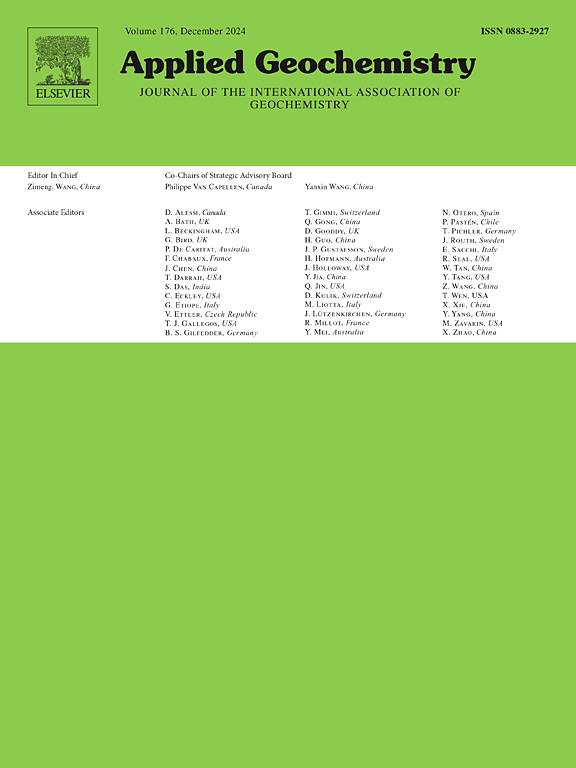用于地质封存应用的水溶液中一氧化碳的精确预测
IF 3.1
3区 地球科学
Q1 GEOCHEMISTRY & GEOPHYSICS
引用次数: 0
摘要
准确预测水溶液的溶解度对一氧化碳的地质封存至关重要。本研究利用电解质版的立方+缔合(CPA)状态方程计算了纯CO的饱和性质,包括饱和蒸汽压、饱和液相密度、饱和气相密度,以及其在纯水中的溶解度和在氯化钠水溶液中的溶解度。根据实验数据验证了模型的准确性,表明饱和液相密度的相对平均偏差在3.0%以内,饱和蒸汽压和饱和气相密度的相对平均偏差在1.0%以内,纯水中CO溶解度的相对平均偏差为4.7%,氯化钠水溶液中CO溶解度的相对平均偏差为1.3%。本工作不仅分析了CO在水溶液中的相行为,而且对CO在这些溶液中的溶解机理进行了深入的讨论。结果表明,电解质版本的CPA状态方程是一个强大的模型,能够准确预测CO的溶解度和CO在水溶液中在广泛的温度、压力和盐浓度范围内的复杂相行为。本文章由计算机程序翻译,如有差异,请以英文原文为准。
Accurate prediction of carbon monoxide in aqueous solutions for geological sequestration applications
Accurate prediction of solubilities in aqueous solutions is crucial for the geological sequestration of carbon monoxide (CO). This study utilizes the electrolyte version of the Cubic-Plus-Association (CPA) Equation of State to calculate the saturated properties including saturated vapor pressure, saturated liquid-phase density, and saturated vapor-phase density of pure CO, its solubilities in pure water, and its solubilities in aqueous sodium chloride solutions. The model accuracy is validated against experimental data, showing relative average deviations within 3.0 % for saturated liquid-phase density, within 1.0 % for both saturated vapor pressure and saturated vapor-phase density, 4.7 % for CO solubilities in pure water, and 1.3 % for CO solubilities in aqueous sodium chloride solutions. This work not only analyzes the phase behavior of CO in aqueous solutions but also provides an in-depth discussion on the dissolution mechanisms of CO in these solutions. The results demonstrate that the electrolyte version of the CPA Equation of State is a robust model capable of accurately predicting CO solubilities and the complex phase behavior of CO in aqueous solutions across a wide range of temperatures, pressures, and salt concentrations.
求助全文
通过发布文献求助,成功后即可免费获取论文全文。
去求助
来源期刊

Applied Geochemistry
地学-地球化学与地球物理
CiteScore
6.10
自引率
8.80%
发文量
272
审稿时长
65 days
期刊介绍:
Applied Geochemistry is an international journal devoted to publication of original research papers, rapid research communications and selected review papers in geochemistry and urban geochemistry which have some practical application to an aspect of human endeavour, such as the preservation of the environment, health, waste disposal and the search for resources. Papers on applications of inorganic, organic and isotope geochemistry and geochemical processes are therefore welcome provided they meet the main criterion. Spatial and temporal monitoring case studies are only of interest to our international readership if they present new ideas of broad application.
Topics covered include: (1) Environmental geochemistry (including natural and anthropogenic aspects, and protection and remediation strategies); (2) Hydrogeochemistry (surface and groundwater); (3) Medical (urban) geochemistry; (4) The search for energy resources (in particular unconventional oil and gas or emerging metal resources); (5) Energy exploitation (in particular geothermal energy and CCS); (6) Upgrading of energy and mineral resources where there is a direct geochemical application; and (7) Waste disposal, including nuclear waste disposal.
 求助内容:
求助内容: 应助结果提醒方式:
应助结果提醒方式:


